Business Communication: Theories, Barriers, and Strategies
VerifiedAdded on 2023/01/11
|9
|2097
|86
AI Summary
This report explores the theories of organizational communication, barriers to communication, and strategies to overcome these barriers in order to improve business communication.
Contribute Materials
Your contribution can guide someone’s learning journey. Share your
documents today.
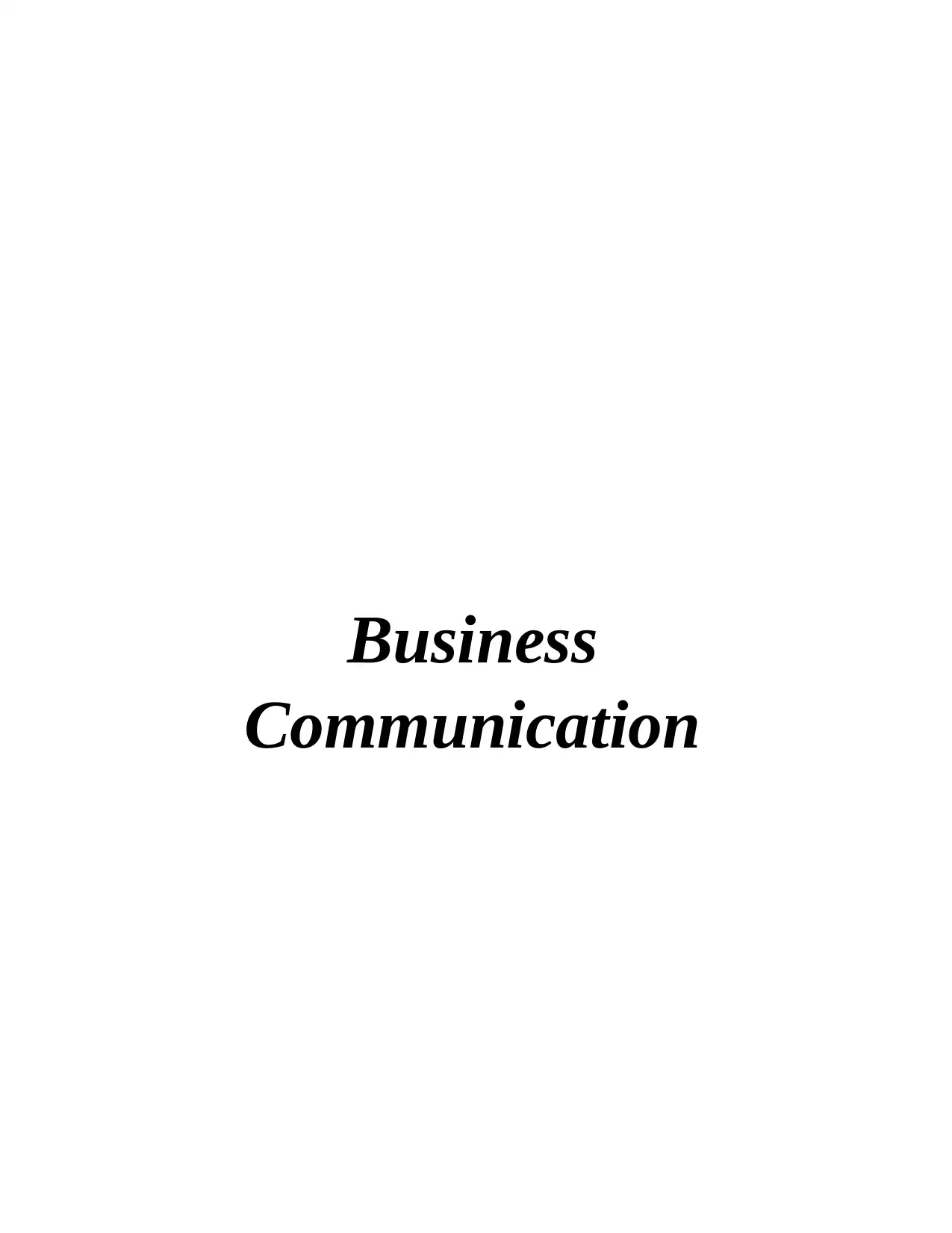
Business
Communication
Communication
Secure Best Marks with AI Grader
Need help grading? Try our AI Grader for instant feedback on your assignments.
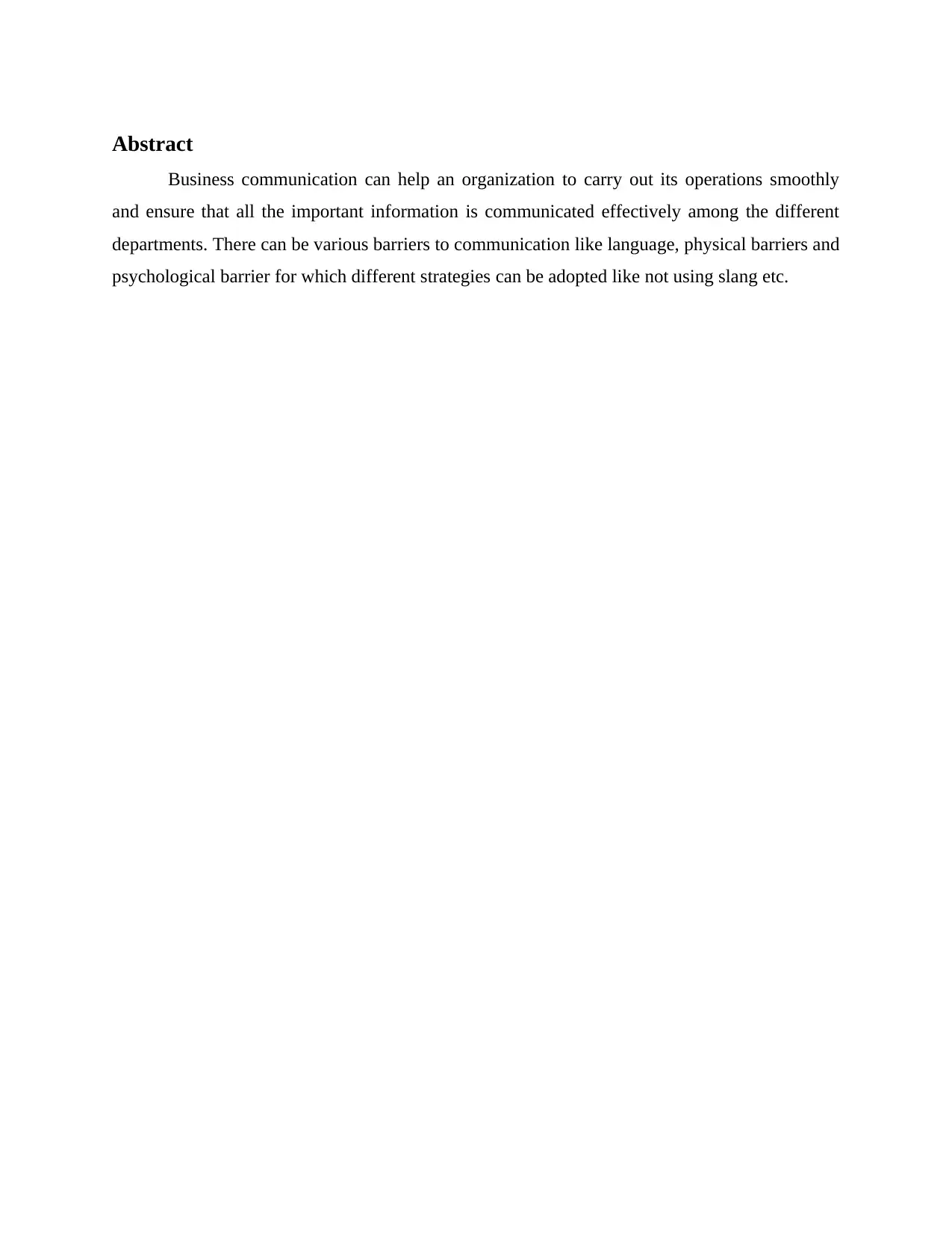
Abstract
Business communication can help an organization to carry out its operations smoothly
and ensure that all the important information is communicated effectively among the different
departments. There can be various barriers to communication like language, physical barriers and
psychological barrier for which different strategies can be adopted like not using slang etc.
Business communication can help an organization to carry out its operations smoothly
and ensure that all the important information is communicated effectively among the different
departments. There can be various barriers to communication like language, physical barriers and
psychological barrier for which different strategies can be adopted like not using slang etc.
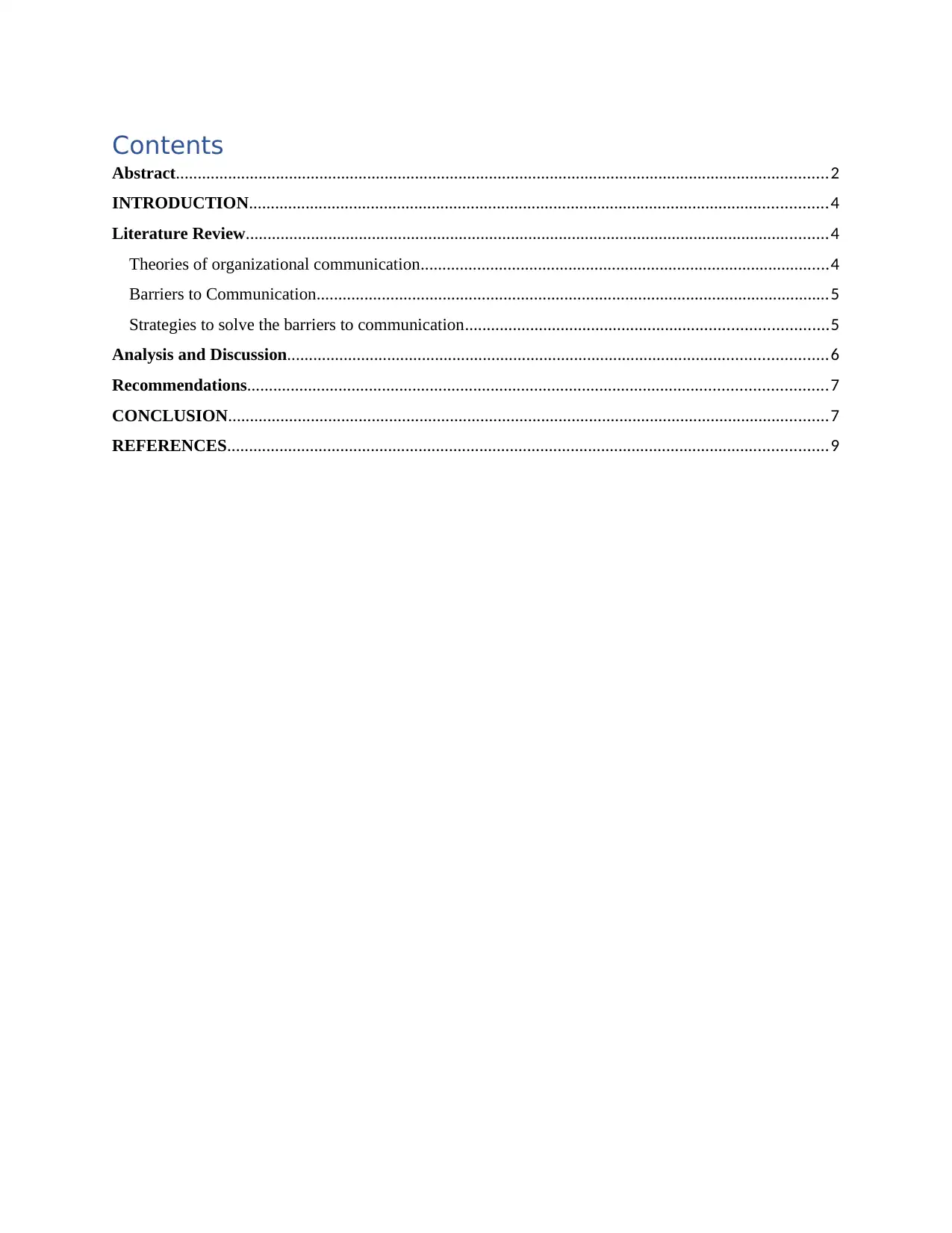
Contents
Abstract......................................................................................................................................................2
INTRODUCTION.....................................................................................................................................4
Literature Review......................................................................................................................................4
Theories of organizational communication..............................................................................................4
Barriers to Communication......................................................................................................................5
Strategies to solve the barriers to communication...................................................................................5
Analysis and Discussion............................................................................................................................6
Recommendations.....................................................................................................................................7
CONCLUSION..........................................................................................................................................7
REFERENCES..........................................................................................................................................9
Abstract......................................................................................................................................................2
INTRODUCTION.....................................................................................................................................4
Literature Review......................................................................................................................................4
Theories of organizational communication..............................................................................................4
Barriers to Communication......................................................................................................................5
Strategies to solve the barriers to communication...................................................................................5
Analysis and Discussion............................................................................................................................6
Recommendations.....................................................................................................................................7
CONCLUSION..........................................................................................................................................7
REFERENCES..........................................................................................................................................9
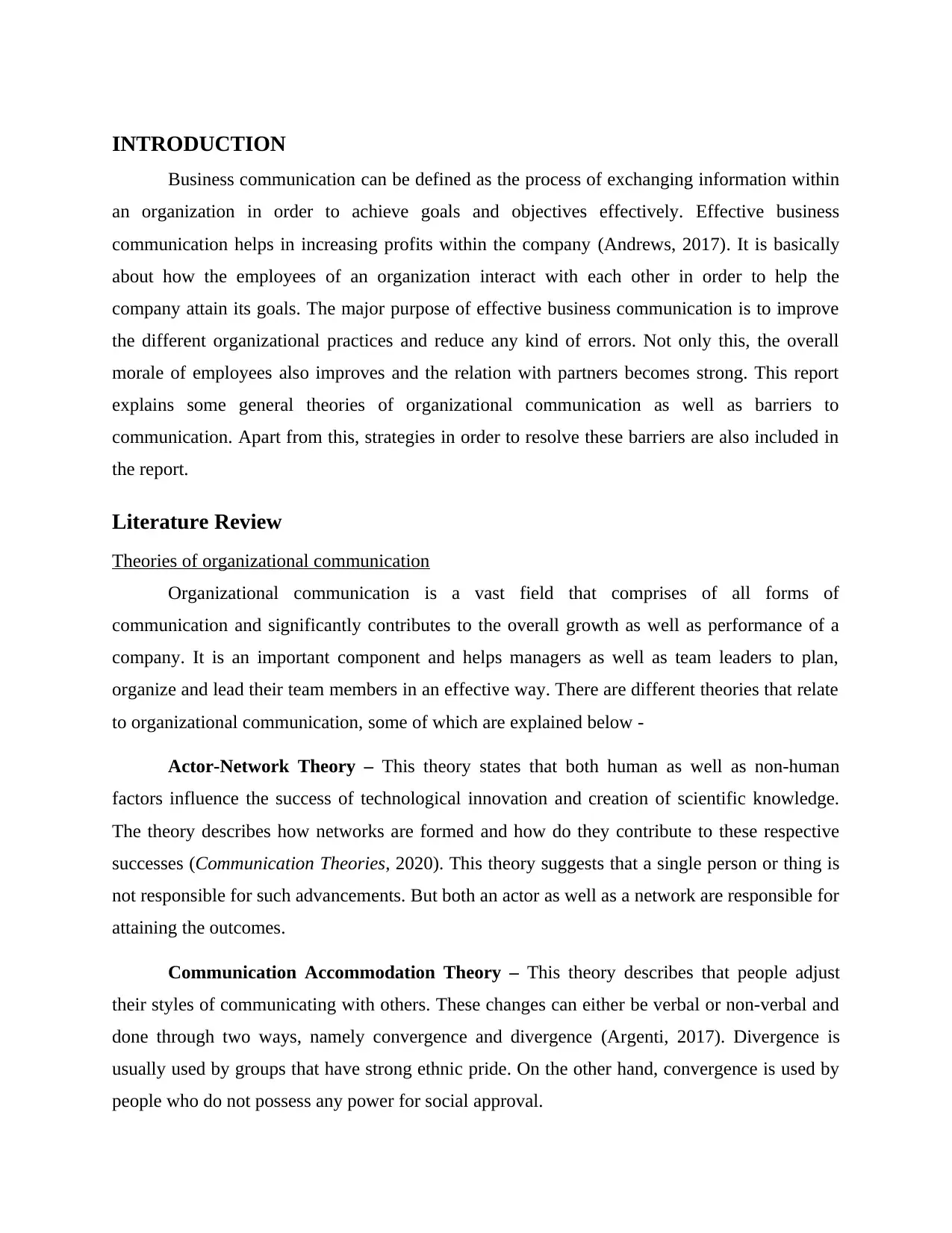
INTRODUCTION
Business communication can be defined as the process of exchanging information within
an organization in order to achieve goals and objectives effectively. Effective business
communication helps in increasing profits within the company (Andrews, 2017). It is basically
about how the employees of an organization interact with each other in order to help the
company attain its goals. The major purpose of effective business communication is to improve
the different organizational practices and reduce any kind of errors. Not only this, the overall
morale of employees also improves and the relation with partners becomes strong. This report
explains some general theories of organizational communication as well as barriers to
communication. Apart from this, strategies in order to resolve these barriers are also included in
the report.
Literature Review
Theories of organizational communication
Organizational communication is a vast field that comprises of all forms of
communication and significantly contributes to the overall growth as well as performance of a
company. It is an important component and helps managers as well as team leaders to plan,
organize and lead their team members in an effective way. There are different theories that relate
to organizational communication, some of which are explained below -
Actor-Network Theory – This theory states that both human as well as non-human
factors influence the success of technological innovation and creation of scientific knowledge.
The theory describes how networks are formed and how do they contribute to these respective
successes (Communication Theories, 2020). This theory suggests that a single person or thing is
not responsible for such advancements. But both an actor as well as a network are responsible for
attaining the outcomes.
Communication Accommodation Theory – This theory describes that people adjust
their styles of communicating with others. These changes can either be verbal or non-verbal and
done through two ways, namely convergence and divergence (Argenti, 2017). Divergence is
usually used by groups that have strong ethnic pride. On the other hand, convergence is used by
people who do not possess any power for social approval.
Business communication can be defined as the process of exchanging information within
an organization in order to achieve goals and objectives effectively. Effective business
communication helps in increasing profits within the company (Andrews, 2017). It is basically
about how the employees of an organization interact with each other in order to help the
company attain its goals. The major purpose of effective business communication is to improve
the different organizational practices and reduce any kind of errors. Not only this, the overall
morale of employees also improves and the relation with partners becomes strong. This report
explains some general theories of organizational communication as well as barriers to
communication. Apart from this, strategies in order to resolve these barriers are also included in
the report.
Literature Review
Theories of organizational communication
Organizational communication is a vast field that comprises of all forms of
communication and significantly contributes to the overall growth as well as performance of a
company. It is an important component and helps managers as well as team leaders to plan,
organize and lead their team members in an effective way. There are different theories that relate
to organizational communication, some of which are explained below -
Actor-Network Theory – This theory states that both human as well as non-human
factors influence the success of technological innovation and creation of scientific knowledge.
The theory describes how networks are formed and how do they contribute to these respective
successes (Communication Theories, 2020). This theory suggests that a single person or thing is
not responsible for such advancements. But both an actor as well as a network are responsible for
attaining the outcomes.
Communication Accommodation Theory – This theory describes that people adjust
their styles of communicating with others. These changes can either be verbal or non-verbal and
done through two ways, namely convergence and divergence (Argenti, 2017). Divergence is
usually used by groups that have strong ethnic pride. On the other hand, convergence is used by
people who do not possess any power for social approval.
Secure Best Marks with AI Grader
Need help grading? Try our AI Grader for instant feedback on your assignments.
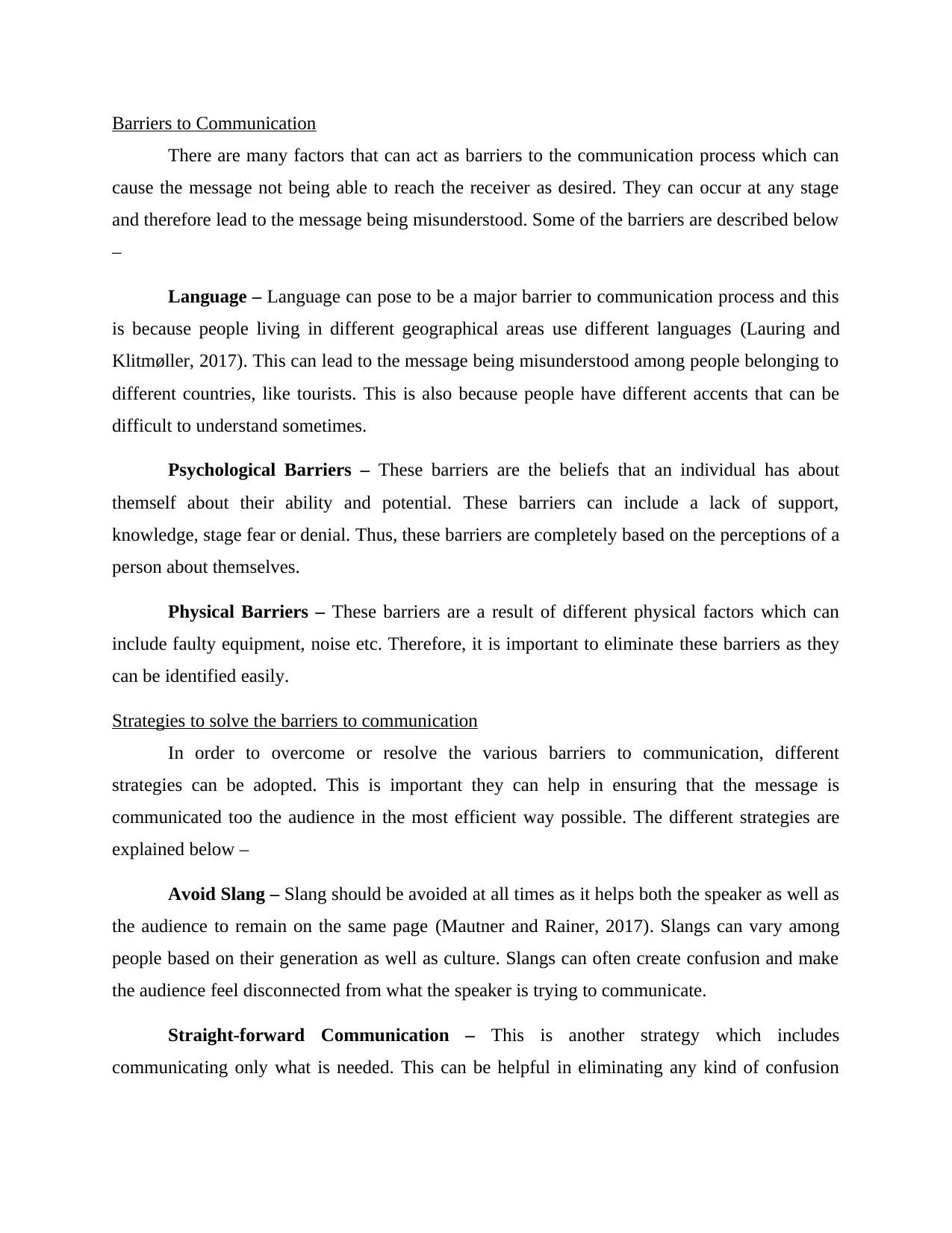
Barriers to Communication
There are many factors that can act as barriers to the communication process which can
cause the message not being able to reach the receiver as desired. They can occur at any stage
and therefore lead to the message being misunderstood. Some of the barriers are described below
–
Language – Language can pose to be a major barrier to communication process and this
is because people living in different geographical areas use different languages (Lauring and
Klitmøller, 2017). This can lead to the message being misunderstood among people belonging to
different countries, like tourists. This is also because people have different accents that can be
difficult to understand sometimes.
Psychological Barriers – These barriers are the beliefs that an individual has about
themself about their ability and potential. These barriers can include a lack of support,
knowledge, stage fear or denial. Thus, these barriers are completely based on the perceptions of a
person about themselves.
Physical Barriers – These barriers are a result of different physical factors which can
include faulty equipment, noise etc. Therefore, it is important to eliminate these barriers as they
can be identified easily.
Strategies to solve the barriers to communication
In order to overcome or resolve the various barriers to communication, different
strategies can be adopted. This is important they can help in ensuring that the message is
communicated too the audience in the most efficient way possible. The different strategies are
explained below –
Avoid Slang – Slang should be avoided at all times as it helps both the speaker as well as
the audience to remain on the same page (Mautner and Rainer, 2017). Slangs can vary among
people based on their generation as well as culture. Slangs can often create confusion and make
the audience feel disconnected from what the speaker is trying to communicate.
Straight-forward Communication – This is another strategy which includes
communicating only what is needed. This can be helpful in eliminating any kind of confusion
There are many factors that can act as barriers to the communication process which can
cause the message not being able to reach the receiver as desired. They can occur at any stage
and therefore lead to the message being misunderstood. Some of the barriers are described below
–
Language – Language can pose to be a major barrier to communication process and this
is because people living in different geographical areas use different languages (Lauring and
Klitmøller, 2017). This can lead to the message being misunderstood among people belonging to
different countries, like tourists. This is also because people have different accents that can be
difficult to understand sometimes.
Psychological Barriers – These barriers are the beliefs that an individual has about
themself about their ability and potential. These barriers can include a lack of support,
knowledge, stage fear or denial. Thus, these barriers are completely based on the perceptions of a
person about themselves.
Physical Barriers – These barriers are a result of different physical factors which can
include faulty equipment, noise etc. Therefore, it is important to eliminate these barriers as they
can be identified easily.
Strategies to solve the barriers to communication
In order to overcome or resolve the various barriers to communication, different
strategies can be adopted. This is important they can help in ensuring that the message is
communicated too the audience in the most efficient way possible. The different strategies are
explained below –
Avoid Slang – Slang should be avoided at all times as it helps both the speaker as well as
the audience to remain on the same page (Mautner and Rainer, 2017). Slangs can vary among
people based on their generation as well as culture. Slangs can often create confusion and make
the audience feel disconnected from what the speaker is trying to communicate.
Straight-forward Communication – This is another strategy which includes
communicating only what is needed. This can be helpful in eliminating any kind of confusion
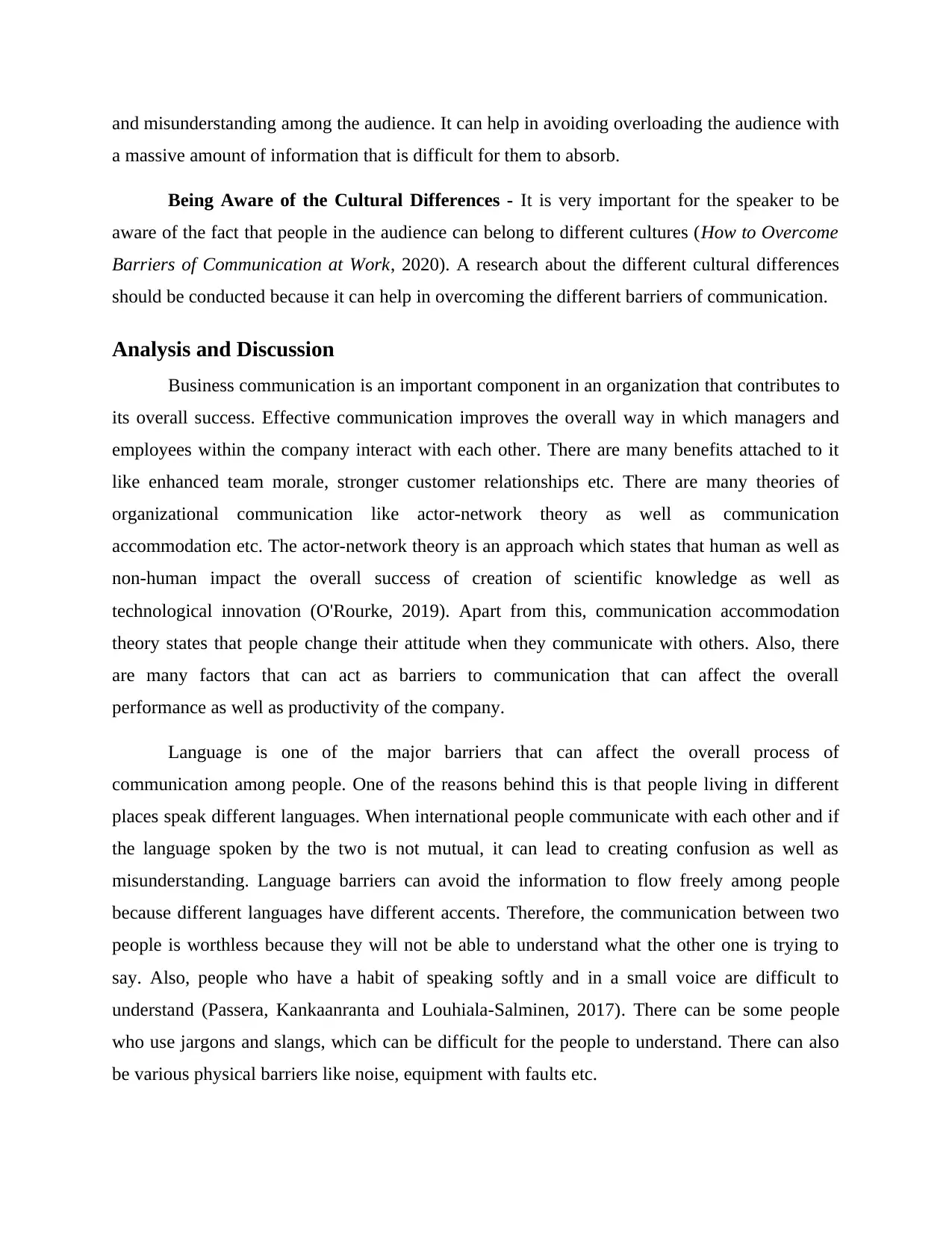
and misunderstanding among the audience. It can help in avoiding overloading the audience with
a massive amount of information that is difficult for them to absorb.
Being Aware of the Cultural Differences - It is very important for the speaker to be
aware of the fact that people in the audience can belong to different cultures (How to Overcome
Barriers of Communication at Work, 2020). A research about the different cultural differences
should be conducted because it can help in overcoming the different barriers of communication.
Analysis and Discussion
Business communication is an important component in an organization that contributes to
its overall success. Effective communication improves the overall way in which managers and
employees within the company interact with each other. There are many benefits attached to it
like enhanced team morale, stronger customer relationships etc. There are many theories of
organizational communication like actor-network theory as well as communication
accommodation etc. The actor-network theory is an approach which states that human as well as
non-human impact the overall success of creation of scientific knowledge as well as
technological innovation (O'Rourke, 2019). Apart from this, communication accommodation
theory states that people change their attitude when they communicate with others. Also, there
are many factors that can act as barriers to communication that can affect the overall
performance as well as productivity of the company.
Language is one of the major barriers that can affect the overall process of
communication among people. One of the reasons behind this is that people living in different
places speak different languages. When international people communicate with each other and if
the language spoken by the two is not mutual, it can lead to creating confusion as well as
misunderstanding. Language barriers can avoid the information to flow freely among people
because different languages have different accents. Therefore, the communication between two
people is worthless because they will not be able to understand what the other one is trying to
say. Also, people who have a habit of speaking softly and in a small voice are difficult to
understand (Passera, Kankaanranta and Louhiala-Salminen, 2017). There can be some people
who use jargons and slangs, which can be difficult for the people to understand. There can also
be various physical barriers like noise, equipment with faults etc.
a massive amount of information that is difficult for them to absorb.
Being Aware of the Cultural Differences - It is very important for the speaker to be
aware of the fact that people in the audience can belong to different cultures (How to Overcome
Barriers of Communication at Work, 2020). A research about the different cultural differences
should be conducted because it can help in overcoming the different barriers of communication.
Analysis and Discussion
Business communication is an important component in an organization that contributes to
its overall success. Effective communication improves the overall way in which managers and
employees within the company interact with each other. There are many benefits attached to it
like enhanced team morale, stronger customer relationships etc. There are many theories of
organizational communication like actor-network theory as well as communication
accommodation etc. The actor-network theory is an approach which states that human as well as
non-human impact the overall success of creation of scientific knowledge as well as
technological innovation (O'Rourke, 2019). Apart from this, communication accommodation
theory states that people change their attitude when they communicate with others. Also, there
are many factors that can act as barriers to communication that can affect the overall
performance as well as productivity of the company.
Language is one of the major barriers that can affect the overall process of
communication among people. One of the reasons behind this is that people living in different
places speak different languages. When international people communicate with each other and if
the language spoken by the two is not mutual, it can lead to creating confusion as well as
misunderstanding. Language barriers can avoid the information to flow freely among people
because different languages have different accents. Therefore, the communication between two
people is worthless because they will not be able to understand what the other one is trying to
say. Also, people who have a habit of speaking softly and in a small voice are difficult to
understand (Passera, Kankaanranta and Louhiala-Salminen, 2017). There can be some people
who use jargons and slangs, which can be difficult for the people to understand. There can also
be various physical barriers like noise, equipment with faults etc.
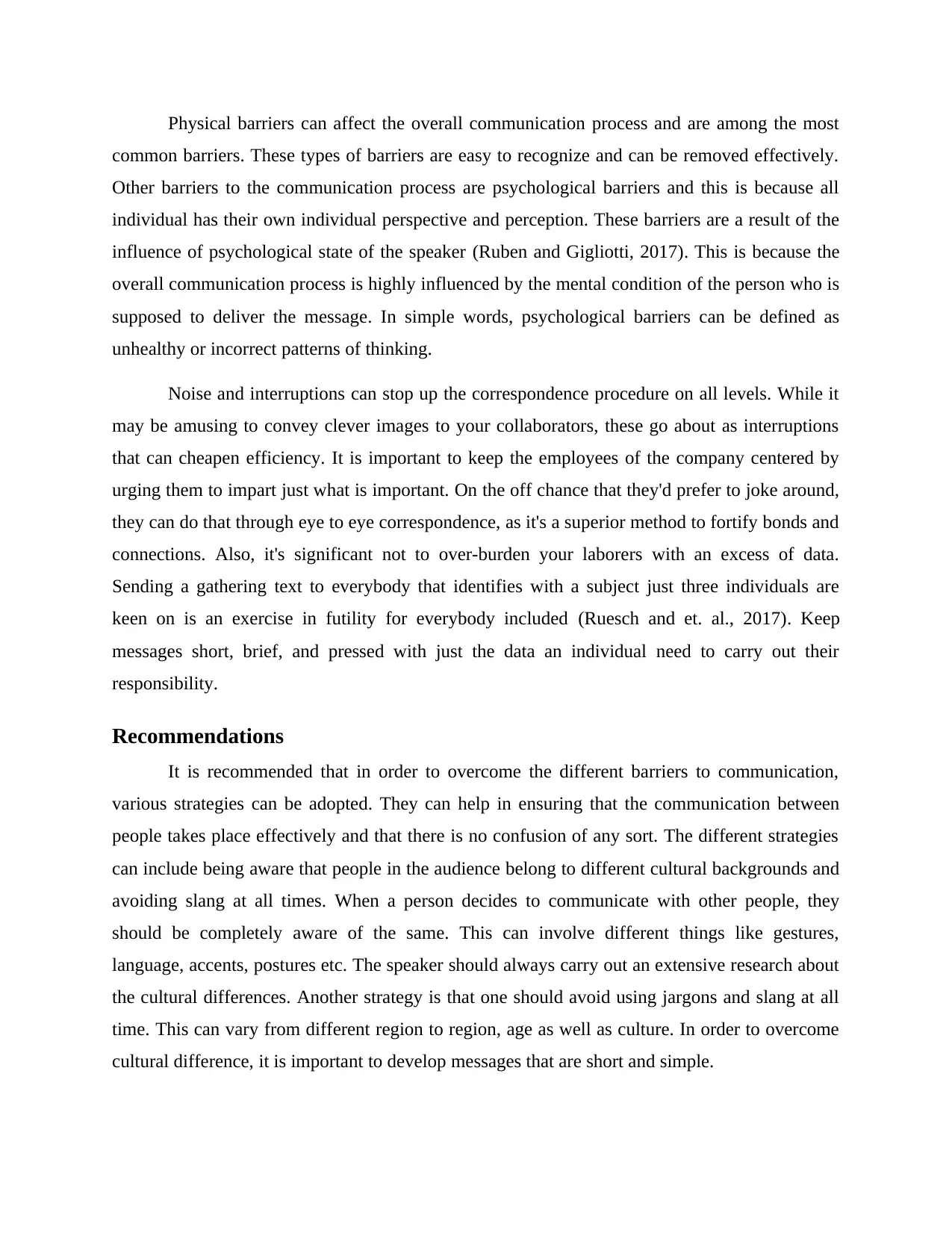
Physical barriers can affect the overall communication process and are among the most
common barriers. These types of barriers are easy to recognize and can be removed effectively.
Other barriers to the communication process are psychological barriers and this is because all
individual has their own individual perspective and perception. These barriers are a result of the
influence of psychological state of the speaker (Ruben and Gigliotti, 2017). This is because the
overall communication process is highly influenced by the mental condition of the person who is
supposed to deliver the message. In simple words, psychological barriers can be defined as
unhealthy or incorrect patterns of thinking.
Noise and interruptions can stop up the correspondence procedure on all levels. While it
may be amusing to convey clever images to your collaborators, these go about as interruptions
that can cheapen efficiency. It is important to keep the employees of the company centered by
urging them to impart just what is important. On the off chance that they'd prefer to joke around,
they can do that through eye to eye correspondence, as it's a superior method to fortify bonds and
connections. Also, it's significant not to over-burden your laborers with an excess of data.
Sending a gathering text to everybody that identifies with a subject just three individuals are
keen on is an exercise in futility for everybody included (Ruesch and et. al., 2017). Keep
messages short, brief, and pressed with just the data an individual need to carry out their
responsibility.
Recommendations
It is recommended that in order to overcome the different barriers to communication,
various strategies can be adopted. They can help in ensuring that the communication between
people takes place effectively and that there is no confusion of any sort. The different strategies
can include being aware that people in the audience belong to different cultural backgrounds and
avoiding slang at all times. When a person decides to communicate with other people, they
should be completely aware of the same. This can involve different things like gestures,
language, accents, postures etc. The speaker should always carry out an extensive research about
the cultural differences. Another strategy is that one should avoid using jargons and slang at all
time. This can vary from different region to region, age as well as culture. In order to overcome
cultural difference, it is important to develop messages that are short and simple.
common barriers. These types of barriers are easy to recognize and can be removed effectively.
Other barriers to the communication process are psychological barriers and this is because all
individual has their own individual perspective and perception. These barriers are a result of the
influence of psychological state of the speaker (Ruben and Gigliotti, 2017). This is because the
overall communication process is highly influenced by the mental condition of the person who is
supposed to deliver the message. In simple words, psychological barriers can be defined as
unhealthy or incorrect patterns of thinking.
Noise and interruptions can stop up the correspondence procedure on all levels. While it
may be amusing to convey clever images to your collaborators, these go about as interruptions
that can cheapen efficiency. It is important to keep the employees of the company centered by
urging them to impart just what is important. On the off chance that they'd prefer to joke around,
they can do that through eye to eye correspondence, as it's a superior method to fortify bonds and
connections. Also, it's significant not to over-burden your laborers with an excess of data.
Sending a gathering text to everybody that identifies with a subject just three individuals are
keen on is an exercise in futility for everybody included (Ruesch and et. al., 2017). Keep
messages short, brief, and pressed with just the data an individual need to carry out their
responsibility.
Recommendations
It is recommended that in order to overcome the different barriers to communication,
various strategies can be adopted. They can help in ensuring that the communication between
people takes place effectively and that there is no confusion of any sort. The different strategies
can include being aware that people in the audience belong to different cultural backgrounds and
avoiding slang at all times. When a person decides to communicate with other people, they
should be completely aware of the same. This can involve different things like gestures,
language, accents, postures etc. The speaker should always carry out an extensive research about
the cultural differences. Another strategy is that one should avoid using jargons and slang at all
time. This can vary from different region to region, age as well as culture. In order to overcome
cultural difference, it is important to develop messages that are short and simple.
Paraphrase This Document
Need a fresh take? Get an instant paraphrase of this document with our AI Paraphraser
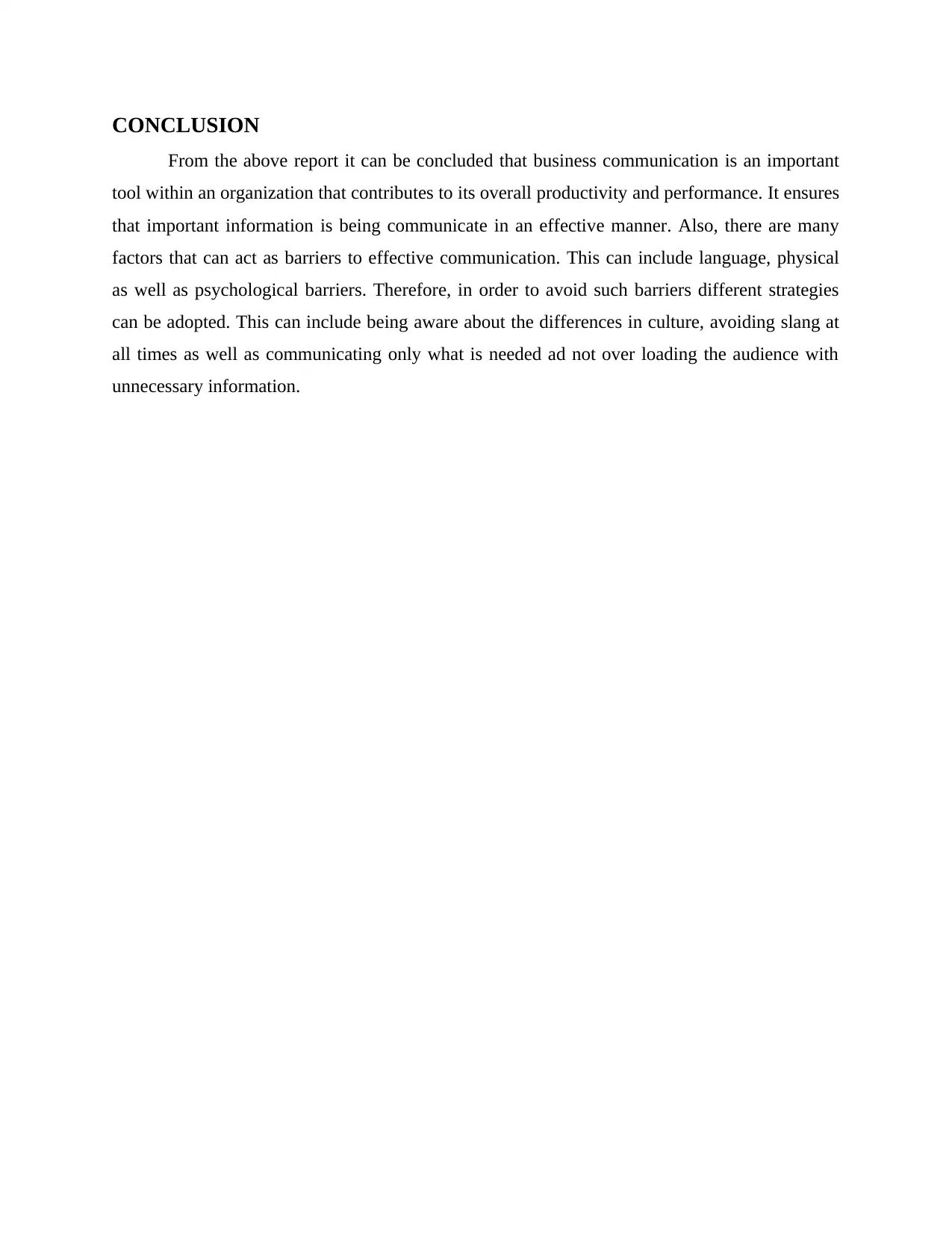
CONCLUSION
From the above report it can be concluded that business communication is an important
tool within an organization that contributes to its overall productivity and performance. It ensures
that important information is being communicate in an effective manner. Also, there are many
factors that can act as barriers to effective communication. This can include language, physical
as well as psychological barriers. Therefore, in order to avoid such barriers different strategies
can be adopted. This can include being aware about the differences in culture, avoiding slang at
all times as well as communicating only what is needed ad not over loading the audience with
unnecessary information.
From the above report it can be concluded that business communication is an important
tool within an organization that contributes to its overall productivity and performance. It ensures
that important information is being communicate in an effective manner. Also, there are many
factors that can act as barriers to effective communication. This can include language, physical
as well as psychological barriers. Therefore, in order to avoid such barriers different strategies
can be adopted. This can include being aware about the differences in culture, avoiding slang at
all times as well as communicating only what is needed ad not over loading the audience with
unnecessary information.
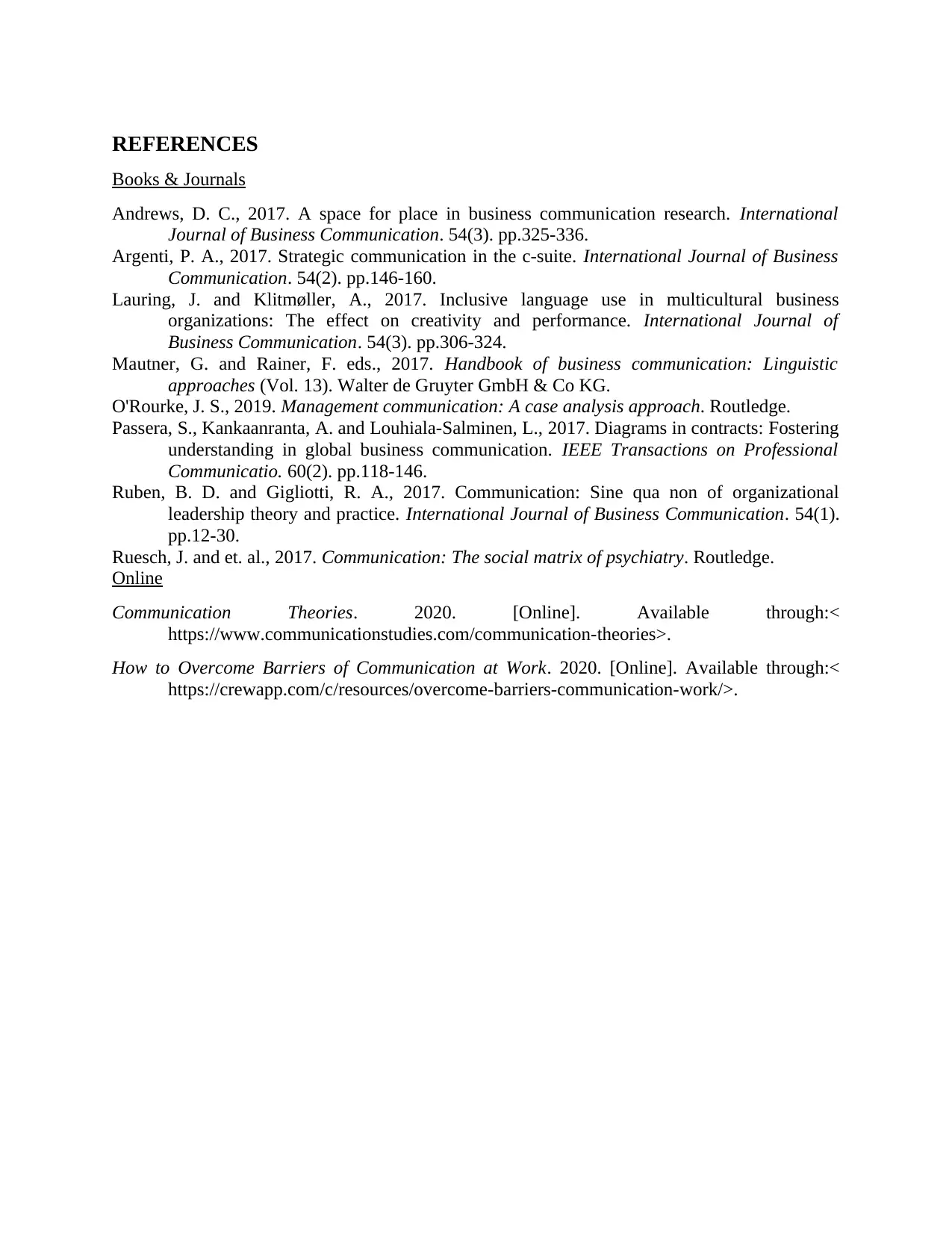
REFERENCES
Books & Journals
Andrews, D. C., 2017. A space for place in business communication research. International
Journal of Business Communication. 54(3). pp.325-336.
Argenti, P. A., 2017. Strategic communication in the c-suite. International Journal of Business
Communication. 54(2). pp.146-160.
Lauring, J. and Klitmøller, A., 2017. Inclusive language use in multicultural business
organizations: The effect on creativity and performance. International Journal of
Business Communication. 54(3). pp.306-324.
Mautner, G. and Rainer, F. eds., 2017. Handbook of business communication: Linguistic
approaches (Vol. 13). Walter de Gruyter GmbH & Co KG.
O'Rourke, J. S., 2019. Management communication: A case analysis approach. Routledge.
Passera, S., Kankaanranta, A. and Louhiala-Salminen, L., 2017. Diagrams in contracts: Fostering
understanding in global business communication. IEEE Transactions on Professional
Communicatio. 60(2). pp.118-146.
Ruben, B. D. and Gigliotti, R. A., 2017. Communication: Sine qua non of organizational
leadership theory and practice. International Journal of Business Communication. 54(1).
pp.12-30.
Ruesch, J. and et. al., 2017. Communication: The social matrix of psychiatry. Routledge.
Online
Communication Theories. 2020. [Online]. Available through:<
https://www.communicationstudies.com/communication-theories>.
How to Overcome Barriers of Communication at Work. 2020. [Online]. Available through:<
https://crewapp.com/c/resources/overcome-barriers-communication-work/>.
Books & Journals
Andrews, D. C., 2017. A space for place in business communication research. International
Journal of Business Communication. 54(3). pp.325-336.
Argenti, P. A., 2017. Strategic communication in the c-suite. International Journal of Business
Communication. 54(2). pp.146-160.
Lauring, J. and Klitmøller, A., 2017. Inclusive language use in multicultural business
organizations: The effect on creativity and performance. International Journal of
Business Communication. 54(3). pp.306-324.
Mautner, G. and Rainer, F. eds., 2017. Handbook of business communication: Linguistic
approaches (Vol. 13). Walter de Gruyter GmbH & Co KG.
O'Rourke, J. S., 2019. Management communication: A case analysis approach. Routledge.
Passera, S., Kankaanranta, A. and Louhiala-Salminen, L., 2017. Diagrams in contracts: Fostering
understanding in global business communication. IEEE Transactions on Professional
Communicatio. 60(2). pp.118-146.
Ruben, B. D. and Gigliotti, R. A., 2017. Communication: Sine qua non of organizational
leadership theory and practice. International Journal of Business Communication. 54(1).
pp.12-30.
Ruesch, J. and et. al., 2017. Communication: The social matrix of psychiatry. Routledge.
Online
Communication Theories. 2020. [Online]. Available through:<
https://www.communicationstudies.com/communication-theories>.
How to Overcome Barriers of Communication at Work. 2020. [Online]. Available through:<
https://crewapp.com/c/resources/overcome-barriers-communication-work/>.
1 out of 9
Related Documents
Your All-in-One AI-Powered Toolkit for Academic Success.
+13062052269
info@desklib.com
Available 24*7 on WhatsApp / Email
![[object Object]](/_next/static/media/star-bottom.7253800d.svg)
Unlock your academic potential
© 2024 | Zucol Services PVT LTD | All rights reserved.





